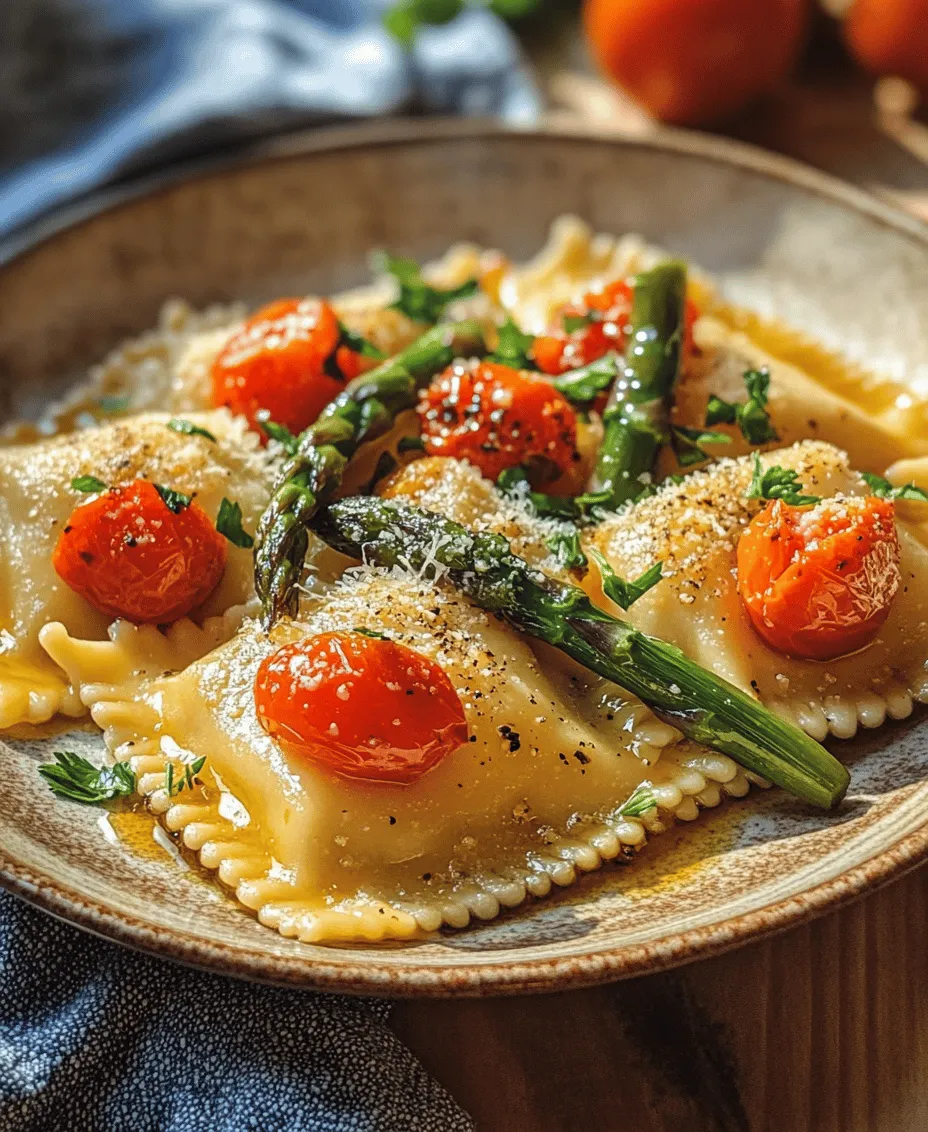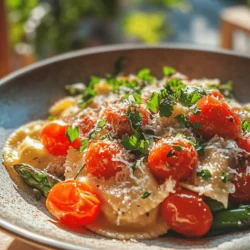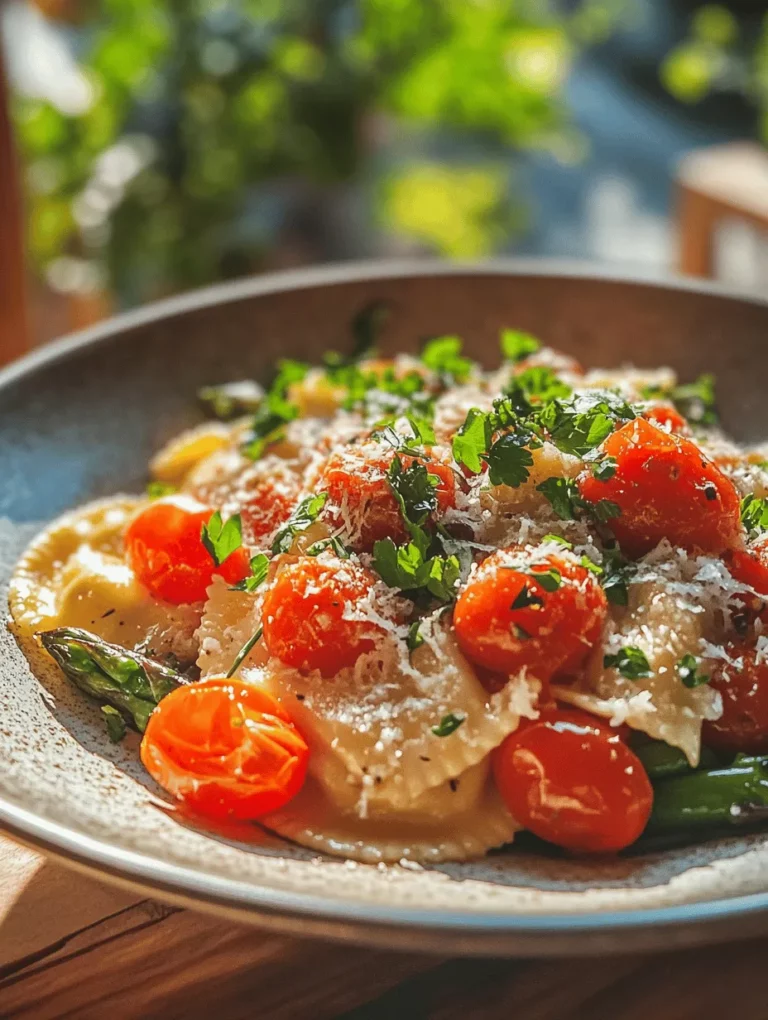Introduction
Herb-infused ravioli with roasted tomatoes and asparagus is a delightful dish that celebrates the vibrant flavors of fresh ingredients. This Italian-inspired meal not only tantalizes the taste buds but also offers a stunning presentation that can impress guests at any dinner party or family gathering. The combination of delicate ravioli stuffed with herby goodness, paired with the sweet burst of roasted cherry tomatoes and the earthy crunch of asparagus, makes for a satisfying and nourishing meal.
One of the key appeals of this dish lies in its commitment to seasonal ingredients. Using fresh produce not only enhances the flavor but also ensures that you’re making the most out of what nature has to offer at any given time of the year. Fresh asparagus is typically in season during the spring, while cherry tomatoes peak during summer, making this recipe a perfect showcase of seasonal bounty. By incorporating these ingredients, you create a dish that is not only delicious but also deeply connected to the rhythms of nature and local farming.
The cooking process for this dish is straightforward, making it accessible for both experienced cooks and beginners. Making homemade ravioli may seem daunting, but the steps are simple and rewarding. Alternatively, using store-bought ravioli can save time without sacrificing flavor. The versatility of this recipe allows for various adaptations; feel free to experiment with different fillings, herbs, or vegetables, tailoring the dish to your preferences and seasonal availability.
Understanding the Ingredients
Fresh vs. Frozen Ravioli
When it comes to ravioli, one of the first decisions you’ll face is whether to use fresh or frozen pasta. Both options have their merits, and your choice may depend on factors such as convenience, flavor, and cooking time.
Fresh Ravioli: Fresh ravioli is typically made with higher-quality ingredients and tends to have a more delicate texture. It cooks quickly, usually requiring just a few minutes in boiling water. Fresh ravioli can be found at specialty grocery stores or made from scratch at home, providing an opportunity to experiment with unique fillings and flavors.
Frozen Ravioli: Frozen ravioli offers convenience and a longer shelf life, making it an excellent option for busy weeknights. The flavor may not always match that of fresh pasta, but many brands have improved their recipes to offer a satisfying taste. When using frozen ravioli, it’s essential to follow the package instructions for cooking times, as they may differ from fresh varieties.
Benefits of Each Type
Both fresh and frozen ravioli can be delicious in their own right, and choosing one over the other largely depends on personal preference and the time you have available. Fresh ravioli can elevate your dish with its texture and flavor, while frozen ravioli is perfect for quick meals without sacrificing too much on taste.
Suggestions on Choosing the Right Filling
When selecting a filling for your ravioli, consider the balance of flavors and textures. Popular fillings include ricotta and spinach, mushroom, or butternut squash. For this herb-infused version, consider using a mixture of ricotta cheese and fresh herbs like basil, parsley, or chives to enhance the dish’s overall freshness.
Health Benefits of Asparagus
Asparagus is not only a delicious vegetable but also a nutritious powerhouse. This green spear is low in calories and high in essential vitamins and minerals. It’s particularly rich in vitamins A, C, E, and K, as well as folate and fiber. Asparagus is also known for its antioxidant properties, which can help combat oxidative stress in the body.
Nutritional Value and Seasonal Availability
Typically in season from late winter through early summer, asparagus is at its best during the spring months. This seasonal availability means that you can enjoy the freshest and most flavorful asparagus when it’s harvested locally. When selecting asparagus, look for firm, bright green stalks with closed tips. Avoid any that appear wilted or rubbery.
The Role of Cherry Tomatoes
Cherry tomatoes add a burst of sweetness and acidity to the dish, balancing the richness of the ravioli. They are small and juicy, making them perfect for roasting. When roasted, cherry tomatoes develop a sweeter flavor and a concentrated taste, elevating any dish they accompany.
Flavor Profile and Cooking Characteristics
Cherry tomatoes have a naturally sweet flavor that intensifies when roasted. Their juicy texture adds moisture to the dish, creating a lovely contrast with the herb-infused ravioli. Incorporating them into your meal not only enhances the flavor but also adds a vibrant color that makes the dish visually appealing.
Fresh Herbs vs. Dried Herbs
The use of fresh herbs in this recipe is crucial for achieving the brightest flavor possible. Fresh herbs offer a vibrant aroma and a more pronounced taste compared to their dried counterparts. When using dried herbs, the flavors can become muted, and the dish may lack the same level of freshness.
For the best results, consider using a combination of fresh herbs like basil, parsley, and chives to infuse the ravioli with flavor. If fresh herbs are unavailable, dried herbs can be used as a substitute, but the quantities may need to be adjusted since dried herbs are more concentrated.
Recommendations for Substitutions
If you’re unable to find certain ingredients, don’t hesitate to make substitutions. For example, if asparagus is out of season, you might try using green beans or zucchini instead. Similarly, if cherry tomatoes are unavailable, sun-dried tomatoes can provide a different but equally delicious flavor profile.
Preparing the Herb-Infused Ravioli
Essential Cooking Tools and Equipment
Before diving into the cooking process, it’s essential to gather all the necessary tools and equipment. Having everything prepared will streamline your cooking experience and ensure that you don’t miss any steps. For this recipe, you will need:
– A baking sheet for roasting vegetables
– A large pot for boiling ravioli
– A skillet for sautéing the vegetables
– A cutting board and sharp knife for prepping ingredients
– Cooking utensils like spatulas and tongs
Step-by-Step Preparation Process
1. Preheating the Oven: Why Temperature Matters
To achieve perfectly roasted vegetables, preheat your oven to 400°F (200°C). This temperature allows for even cooking and caramelization, which enhances the flavor of the tomatoes and asparagus. Preheating is a crucial step that should not be overlooked, as it ensures that your ingredients begin cooking immediately upon entering the oven.
2. Preparing the Vegetables: Cutting Techniques and Tips
While your oven is preheating, take time to prepare the vegetables. Rinse the asparagus under cold water and trim the woody ends by snapping off the bottom inch or so. Cut the asparagus into approximately 2-inch pieces for even cooking. For the cherry tomatoes, simply halve them, allowing the juices to escape and intensify during roasting.
3. Seasoning: Importance of Balancing Flavors
In a large mixing bowl, combine the halved cherry tomatoes and cut asparagus. Drizzle with olive oil and season generously with salt and freshly cracked black pepper. Toss the vegetables together to ensure an even coating of oil and seasoning. The right balance of flavors is vital, as it enhances the natural sweetness of the tomatoes and the earthiness of the asparagus.
Roasting the Vegetables
The Roasting Process
Once your vegetables are seasoned and your oven is hot, spread the asparagus and cherry tomatoes on the prepared baking sheet in a single layer. This ensures that they roast evenly and develop that desirable caramelized exterior. Place the baking sheet in the preheated oven and roast for about 20-25 minutes, or until the vegetables are tender and slightly charred at the edges.
Ideal Temperatures and Times for Optimal Results
Roasting vegetables at 400°F (200°C) is ideal for achieving caramelization without burning. Keep an eye on them, as cooking times may vary based on the size of your vegetable pieces and your oven’s performance. Halfway through the roasting process, give the vegetables a toss to promote even cooking and prevent sticking.
Flavor Development through Roasting
The roasting process is not just about cooking; it’s about transforming the ingredients. As the vegetables roast, their natural sugars caramelize, which enhances their sweetness and brings out deeper flavors. The slight char adds complexity, making each bite of your dish rich and satisfying. The combination of the roasted tomatoes and asparagus will serve as a perfect accompaniment to the herb-infused ravioli, creating a dish that is as flavorful as it is visually appealing.
As you prepare to mix these vibrant roasted vegetables with your herb-infused ravioli, you’re setting the stage for a delightful culinary experience that showcases the best of what the season has to offer.
Stay tuned for the next part of this article, where we will delve deeper into cooking the ravioli, assembling the dish, and serving suggestions that will elevate your dining experience even further.

How Heat Enhances the Taste of Tomatoes and Asparagus
When roasting vegetables, the application of heat plays a pivotal role in developing their flavors. As tomatoes and asparagus are exposed to high temperatures, natural sugars caramelize, resulting in a deeper sweetness and richer taste. This transformation is due to the Maillard reaction—a process where amino acids and reducing sugars interact under heat, creating complex flavor compounds.
Tomatoes, in particular, benefit immensely from this cooking method. The concentrated flavors become more pronounced as moisture evaporates, leading to a burst of umami. On the other hand, asparagus develops a tender yet slightly crisp texture, showcasing its earthy notes. When combined in this dish, the roasted tomatoes and asparagus not only enhance the ravioli but also create a symphony of flavors that is a delight for the palate.
Visual Cues for Doneness
Identifying when your vegetables are perfectly roasted involves observing several visual cues. For tomatoes, look for skins that have blistered and begun to brown slightly, indicating they have released their juices and caramelized. The flesh should appear soft and tender, yet still hold its shape.
As for asparagus, it should be vibrant green and slightly charred at the tips. The stem should yield to gentle pressure but still retain a bit of crispness. Both vegetables should look glistening, a sign that they have cooked through without drying out. These visual indicators will ensure that your dish achieves that perfect balance of flavor and texture.
Cooking the Ravioli
Techniques for Boiling Ravioli
Cooking ravioli might seem straightforward, but mastering the technique can elevate your dish significantly. Begin by bringing a large pot of water to a rolling boil. Once boiling, gently add your ravioli, ensuring not to overcrowd the pot, which can lead to uneven cooking.
Importance of Salted Water
It’s crucial to season your boiling water generously with salt. This step is often overlooked, but it serves two purposes: it enhances the flavor of the pasta itself and helps to season the ravioli from the inside out as they cook. A good rule of thumb is to use about one tablespoon of salt per gallon of water.
Tips for Avoiding Overcooking
To prevent overcooking, closely monitor your ravioli as they cook. Fresh ravioli typically only need 3-5 minutes, while frozen varieties may require an additional minute or two. As soon as they float to the surface of the water, they are generally indicative of being done. Use a slotted spoon to test one for doneness if you’re unsure.
Combining Ingredients for Best Flavor
Reserve about a cup of the pasta water before draining the ravioli. This starchy water can be a game changer when combining your ingredients. The starch helps thicken the sauce and allows for better adhesion of the flavors to the pasta.
The Purpose of Reserved Pasta Water
The reserved pasta water is an essential component when bringing everything together. It serves as a binding agent, ensuring that the ravioli are coated with the flavors of your roasted vegetables and any added herbs or sauces. It can also help loosen the mixture if it appears too dry.
Importance of Gentle Tossing to Maintain Ravioli Integrity
When combining the roasted vegetables with your ravioli, be gentle. Use a large spoon or spatula to carefully toss the ravioli with the vegetables and any reserved pasta water. This technique prevents the ravioli from breaking apart, preserving their shape and texture.
Bringing It All Together
Combining Roasted Vegetables and Ravioli
Once your ravioli are cooked and drained, it’s time to combine them with the roasted tomatoes and asparagus. In a large mixing bowl, add the ravioli and gently fold in the roasted vegetables. The goal is to create an even distribution of flavors without damaging the delicate ravioli.
Techniques for Even Distribution of Ingredients
To achieve an even distribution, consider layering the ravioli and vegetables in the mixing bowl. Start with half of the ravioli, then add half of the roasted vegetables, and repeat. This method ensures that each serving will get a fair share of both components.
Adjusting Seasoning for Personal Preference
Before serving, taste your dish and adjust the seasoning as needed. A sprinkle of salt, a dash of pepper, or a hint of crushed red pepper flakes can enhance the overall flavor profile. Consider also adding freshly chopped herbs like basil or parsley for an additional layer of freshness.
How to Taste and Modify the Dish Before Serving
When tasting, think about the balance of flavors. If the dish feels too rich, a squeeze of fresh lemon juice can brighten the flavors. Conversely, if it needs warmth, a pinch of nutmeg or a drizzle of olive oil can add depth. This is your opportunity to personalize the dish to your liking.
Serving Suggestions
Presentation Ideas for Herb-Infused Ravioli
Presentation plays a crucial role in the dining experience. When serving your herb-infused ravioli, consider using a large, shallow bowl. This allows for a beautiful display of the colorful roasted vegetables atop the ravioli. Garnish with a sprinkle of fresh herbs and a drizzle of high-quality olive oil to enhance visual appeal.
Plating Techniques for Appealing Visuals
For a more refined look, use a ring mold to stack the ravioli in the center of the plate, then artfully arrange the roasted tomatoes and asparagus around it. Finish with a sprinkle of grated Parmesan cheese or a vegan alternative, and consider using microgreens for an elegant touch.
Pairing Recommendations
Pair your herb-infused ravioli with a light green salad dressed in a vinaigrette to complement the richness of the dish. A simple arugula salad with lemon and olive oil can provide a refreshing contrast.
Suggested Beverages and Side Dishes That Complement the Meal
For beverages, a crisp white wine such as Pinot Grigio or a light-bodied red like Chianti works beautifully with this dish. If you prefer non-alcoholic options, consider sparkling water with a twist of lemon or a refreshing herbal iced tea.
Nutritional Information
Breakdown of Calories and Macronutrients Per Serving
This herb-infused ravioli with roasted tomatoes and asparagus is not only delicious but also nutritious. A typical serving contains approximately 400-500 calories, depending on portion size and ingredients used. The macronutrient breakdown typically includes:
– Calories: 450
– Protein: 15g
– Carbohydrates: 65g
– Fats: 18g
Health Benefits of Ingredients Used in the Recipe
The ingredients in this dish bring a wealth of health benefits. Tomatoes are rich in antioxidants, particularly lycopene, which is linked to numerous health benefits, including heart health. Asparagus is a good source of vitamins A, C, E, and K, and is known for its anti-inflammatory properties. The whole grain or gluten-free ravioli adds fiber and sustenance, making this a balanced meal.
Vegetarian and Dietary Considerations
This recipe is naturally vegetarian, making it suitable for those looking to reduce their meat consumption. For gluten-free options, simply choose gluten-free ravioli. Additionally, the dish can be adjusted to be vegan by omitting cheese or using a dairy-free alternative.
Conclusion
In summary, Herb-Infused Ravioli with Roasted Tomatoes and Asparagus is a simple yet sophisticated dish that showcases the beauty of fresh, seasonal ingredients. The interplay of flavors from the roasted vegetables and the delicate pasta creates a memorable meal that is both satisfying and nourishing.
We encourage you to explore this recipe and make it your own. Feel free to incorporate variations, such as swapping in different vegetables or experimenting with sauces and herbs. Cooking is a joy, especially when you can use fresh ingredients to create something delightful. Embrace the process, and revel in the satisfaction that comes from preparing homemade meals that bring warmth and happiness to your table.

